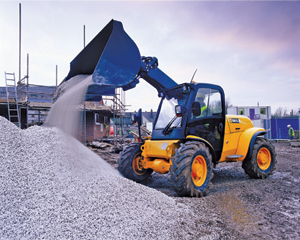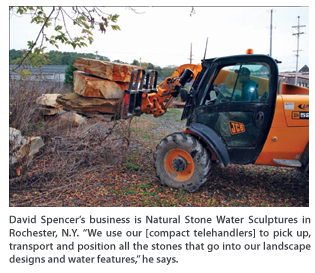Added Reach

When it comes to moving materials on the jobsite, compact telescopic handlers can tackle the task with both precision and speed. While full-size telehandlers may offer a longer reach and greater lifting capacity, their smaller descendents offer more versatility, making them useful in construction, agriculture and landscaping applications. Their compact size and tight turning radius helps them navigate around obstacles and deliver materials in confined areas where larger equipment would be unable to fit. In fact, according to Jim Blower, senior product marketing manager for JCB North America, compact telehandlers can often take on jobs usually handled by other types of equipment.
 “Compact telehandlers can be outfitted with a number of attachments, making them able to perform many of the same tasks as a skid steer loader, for example,” Blower explains. “While skid steers are also maneuverable and useful in crowded spaces, compact telehandlers have an extendable boom that provides greater reach if you’ll be lifting loads across obstacles or up to a higher level. Some compact telehandlers can even be used as a compact loader when outfitted with the appropriate bucket attachment.”
“Compact telehandlers can be outfitted with a number of attachments, making them able to perform many of the same tasks as a skid steer loader, for example,” Blower explains. “While skid steers are also maneuverable and useful in crowded spaces, compact telehandlers have an extendable boom that provides greater reach if you’ll be lifting loads across obstacles or up to a higher level. Some compact telehandlers can even be used as a compact loader when outfitted with the appropriate bucket attachment.”
“Compact telehandlers are one of the most versatile machines that we sell,” says Greg McGibboney, sales representative for Associated Supply Co. [ASCO] of Lubbock, Texas. “While there will always be a need for other types of compact equipment like skid steers and mini excavators, compact telehandlers are becoming extremely popular because not only are they adept at moving heavy loads, they’re also smaller, faster and they can lift those loads much higher.”
Paul Maher, sales manager for Liftech Equipment Companies of East Syracuse, N.Y., also believes in the value of these mighty little machines. “A customer will often purchase a compact telehandler based upon someone else’s recommendation, and they’re a little wary of how useful it will be on their work site,” Maher explains. “But once they start using one of these machines, they often wonder how they ever managed without it.”
These long-reach compact tool carriers are popular with a variety of contractors and equipment owners. Utilizing a bucket, grapple, broom or man lift attachment, compact telehandlers can perform a litany of jobsite tasks in regular and elevated environments. The following owner profiles demonstrate just a few of the many ways these versatile machines can be used.
Hamilton Feed and Grain
Coleman, Okla.
Hamilton Feed and Grain of Coleman, Okla. specializes in the manufacture and sale of both seed and “Ko-zees” — wood pellets used as an efficient fuel source for wood stoves. The mill also sells fertilizers and produces a commercial pecan crop. According to owner Dan Hamilton, he and his crew use a JCB 527-55 compact telehandler purchased from Pettit Machinery in Ardmore, Okla., for just about every tough job around their worksite.
“We move logs for wood pellets, piles of sawdust, dirt, you name it,” Hamilton says. “When brush accumulates around the property, we break it up with our brush rake and then use the compact telehandler to move and dispose of it. And, because our machine has such a wide bucket, we can also use it to load pecan trash and composting materials up into 12-ft by 6-ft truck beds.”
Hamilton says the most important features of his compact telehandler are its maneuverability, lifting capacity and its ability to extend loads far out in front of the operator without sacrificing stability. “With its four-wheel drive and tight turning radius, it can go just about anywhere,” Hamilton explains. “If you’d happen to get stuck in some rough terrain, you can just push yourself out by extending the low, off-set boom.”
When Hamilton purchased his first compact telehandler in November 2007, he had no experience using this type of machine and was a little skeptical that it would really make a huge difference in his overall efficiency. “Now, I really don’t think we could run this operation without our compact telehandler,” Hamilton says. “It does so many different things well that we use it on a daily basis.”
Natural Stone Water Sculptures
Rochester, N.Y.
Moving large stones and slabs into the relatively small confines of residential backyards is an essential part of David Spencer’s business, Natural Stone Water Sculptures of Rochester, N.Y. Fortunately, his compact telehandler makes what could be a difficult task much easier.
“We use our machine to pick up, transport and position all the stones that go into our landscape designs and water features,” Spencer says. “By attaching a bucket to it, we can also move all sorts of other material throughout the landscape, including soil and gravel.”
In the past, Spencer used a skid steer loader when working with his water sculpture designs. Now, he attaches heavy-duty forks to his JCB 524-50 to perform specialized work with boulders and slabs of stone. “We eventually outgrew the skid steer because we needed to lift heavier stones for the larger sculptures,” Spencer explains. “Our compact telehandler can handle up to 2.5 tons with no problem. I can quickly approach these large slabs, lift them and move them into place in just a matter of minutes.”
Spencer feels the investment in his compact telehandler was definitely worth it, as he can finish each job more quickly and move onto the next one, allowing him to work with more clients in the same amount of time. “I’ve looked at other types of heavy equipment and most are extremely expensive in comparison to my compact telehandler, yet they don’t offer any additional functionality,” Spencer says. “Plus, my machine is comfortable and easy to use — what more could I ask for?”
Bianchi Bark & Gravel
Grapeview, Wash.
Jim Bianchi of Bianchi Bark & Gravel also works closely with rocks — but on a much smaller scale. “My business offers bark, gravel, limestone, lava rock and top soil for landscape use,” Bianchi says. “I retail these products directly to homeowners, and I also sell them on a wholesale basis to landscape contractors.”

Bianchi’s skid steers weren’t able to reach high enough to load many of the large trucks used by many of his wholesale customers. Luckily, a friend who’d received a JCB brochure featuring a compact telehandler brought the machine to Bianchi’s attention. When he checked out the machine at a dealership, he was immediately pleased with its maneuverability and extendable boom, which allowed him to stack material much more than before.
Safety and comfort also played a role in Bianchi’s decision to purchase a compact telehandler. “I’m 72 years old, and the side entry door on my machine’s cab makes it much easier for me to get in and out,” Bianchi says. “Plus, when I used my old skid steer, I often had to lift loads up almost directly over my head in order to get them up far enough to dump into high-sided truck beds or trailers. With the extended boom of my telehandler, I can always keep loads far enough out in front of me that I don’t risk dumping them on top of my machine.”
The compact telehandler has also had a positive effect on Bianchi’s bottom line. “Say I need to move 7 yds of gravel,” Bianchi says. “With my old skid steer, it would’ve taken 14 trips, but with my telehandler, I only need to make seven trips, and it takes half the time. That makes a big difference when you’re averaging ten deliveries a day.”
Lynette Von Minden is public relations counsel for Swanson Russell, based in Lincoln, Neb.

Comments are closed here.